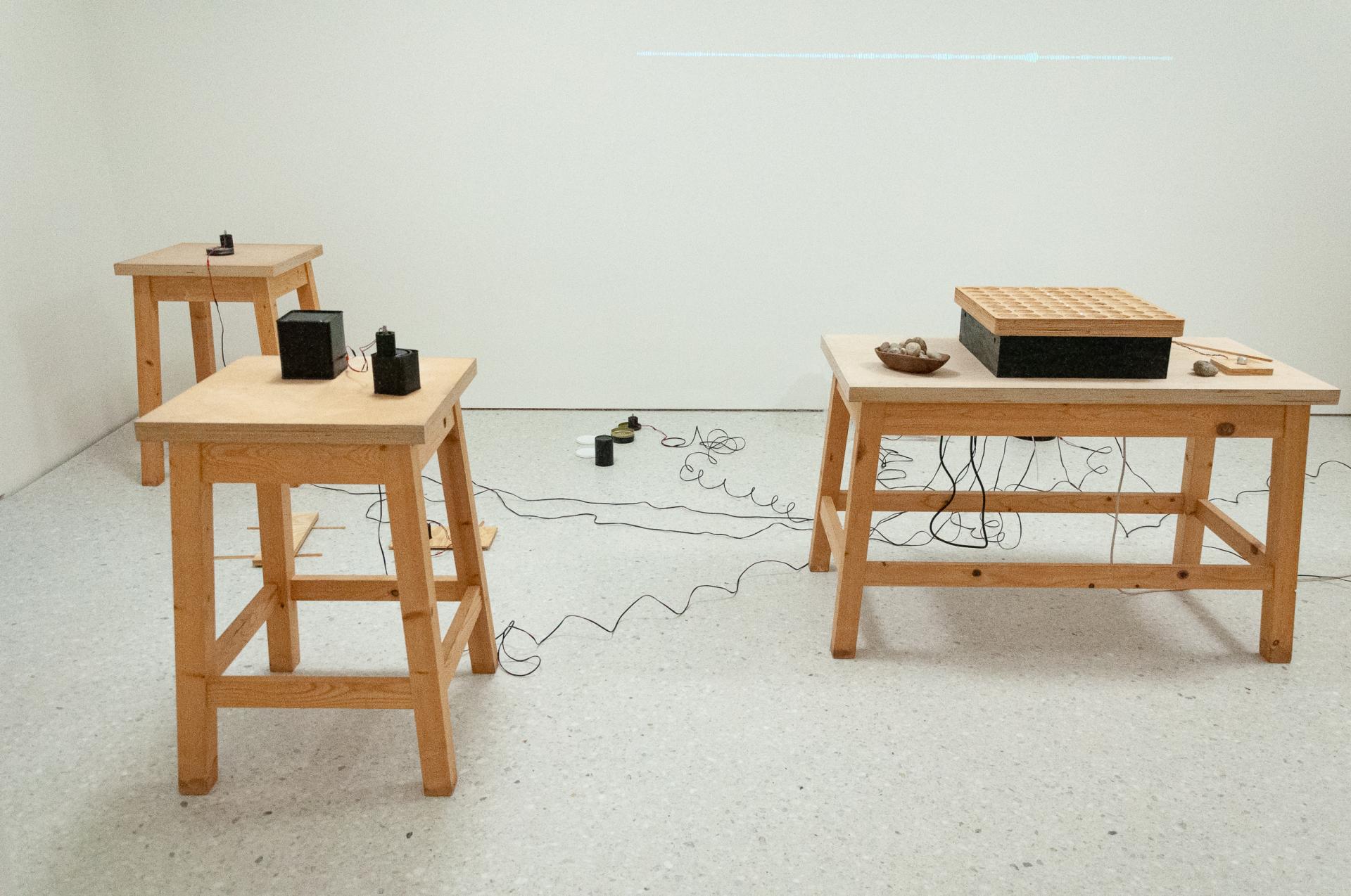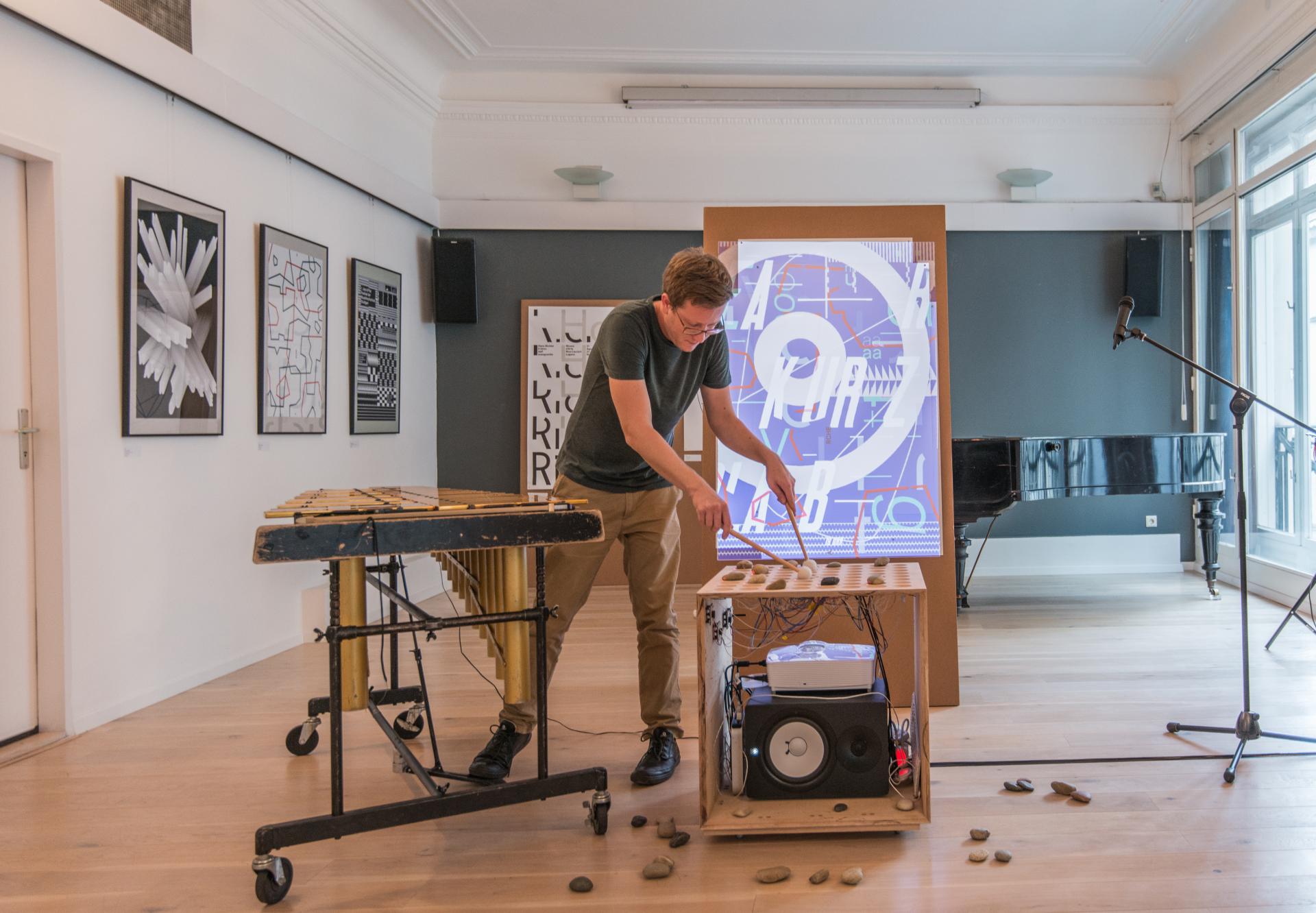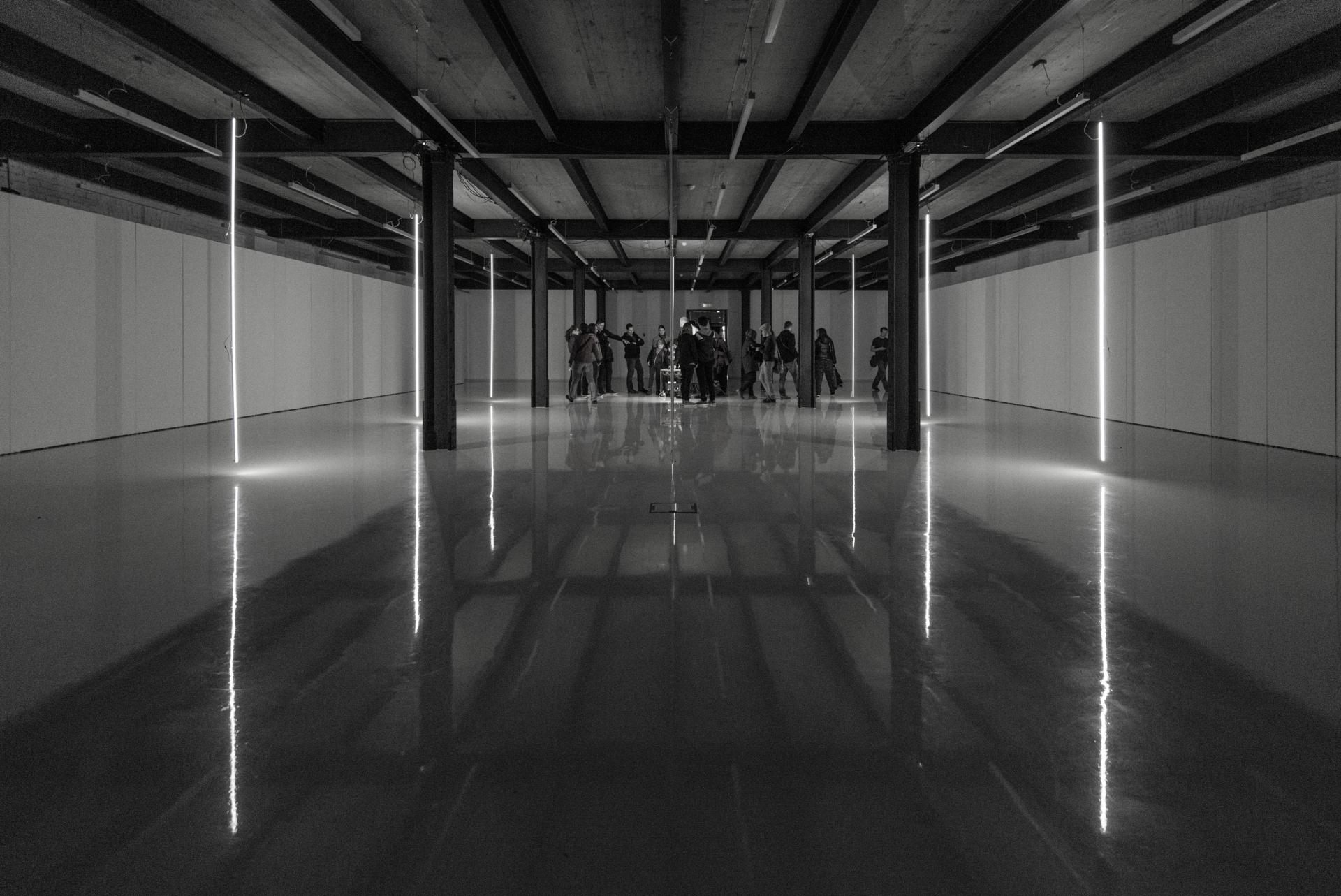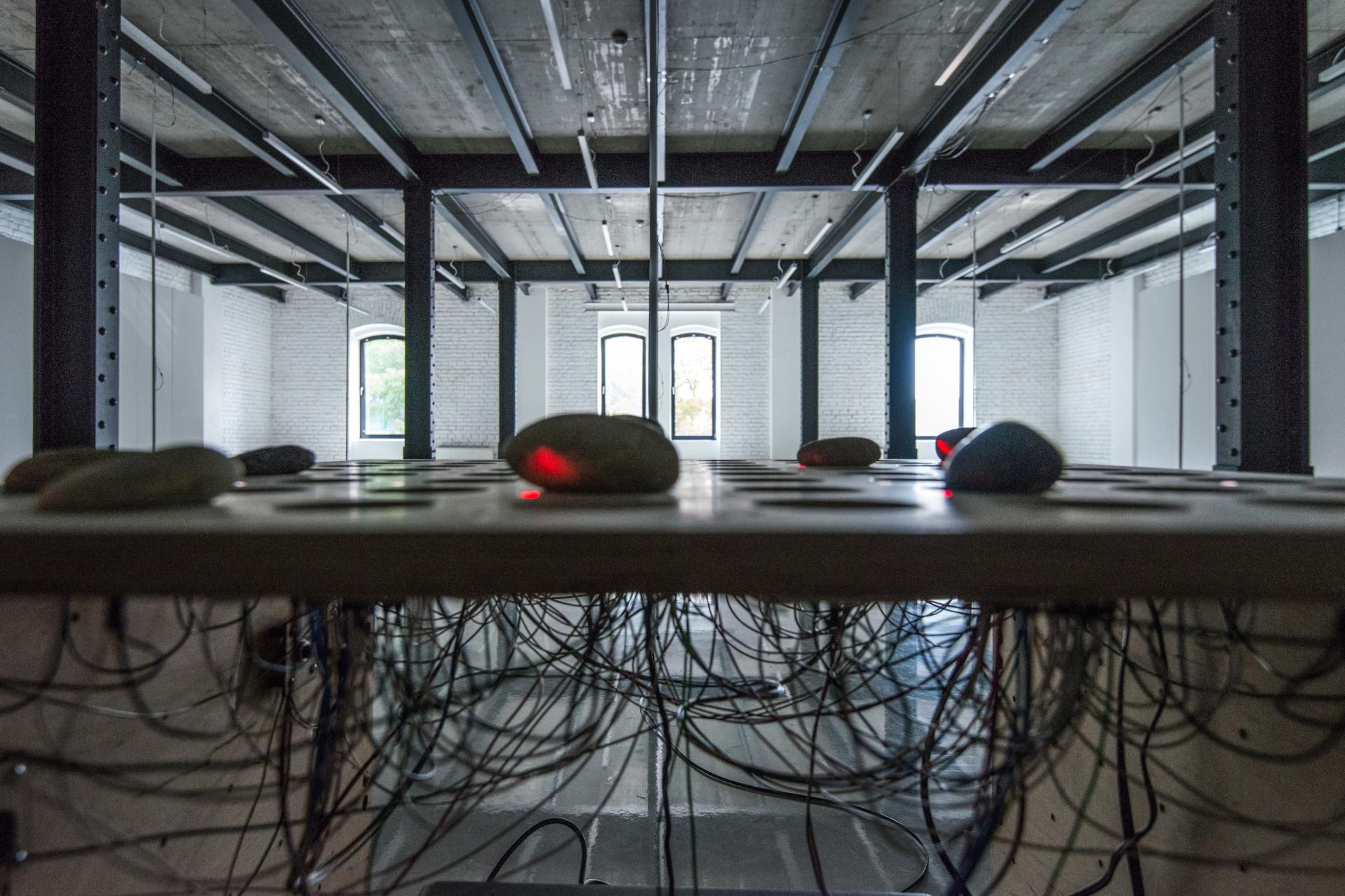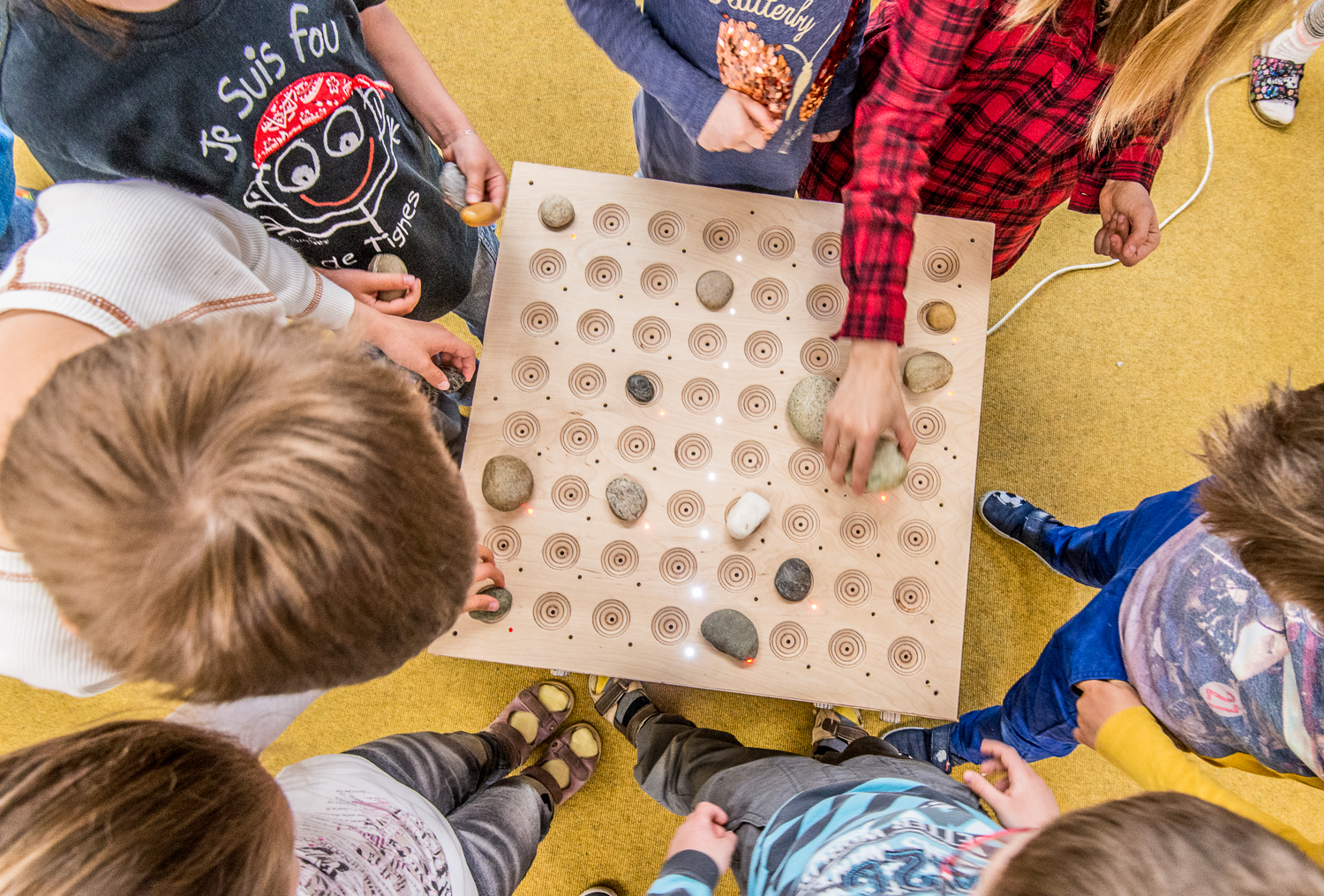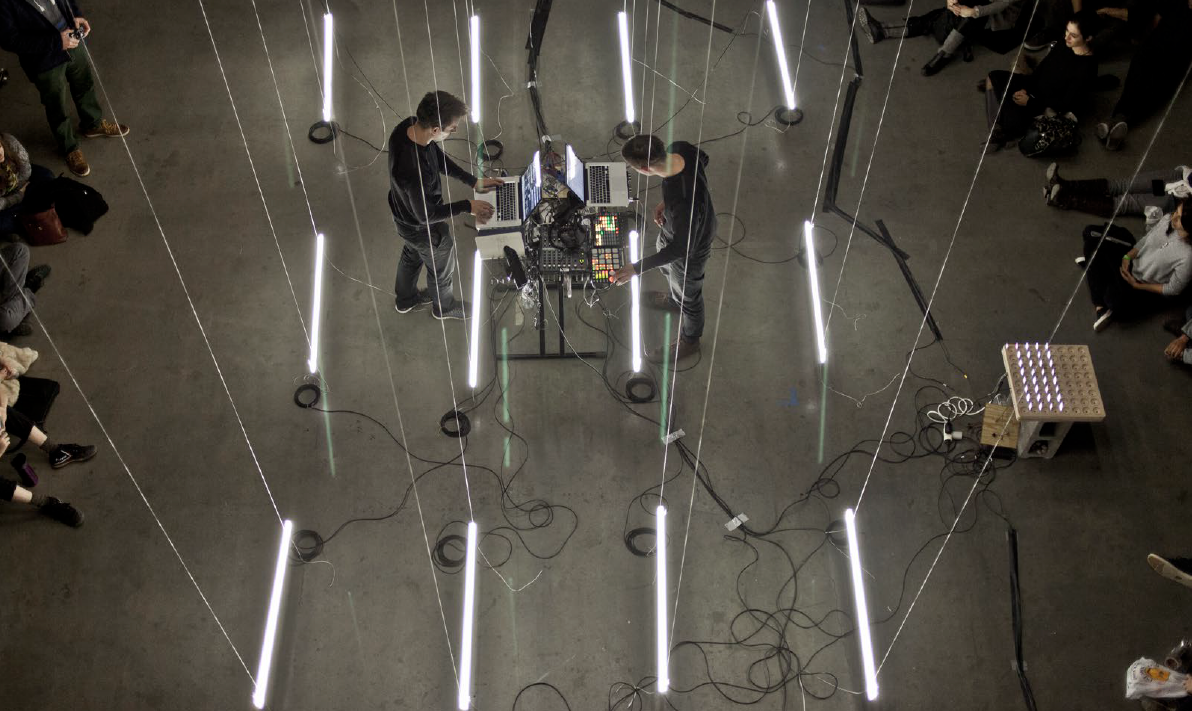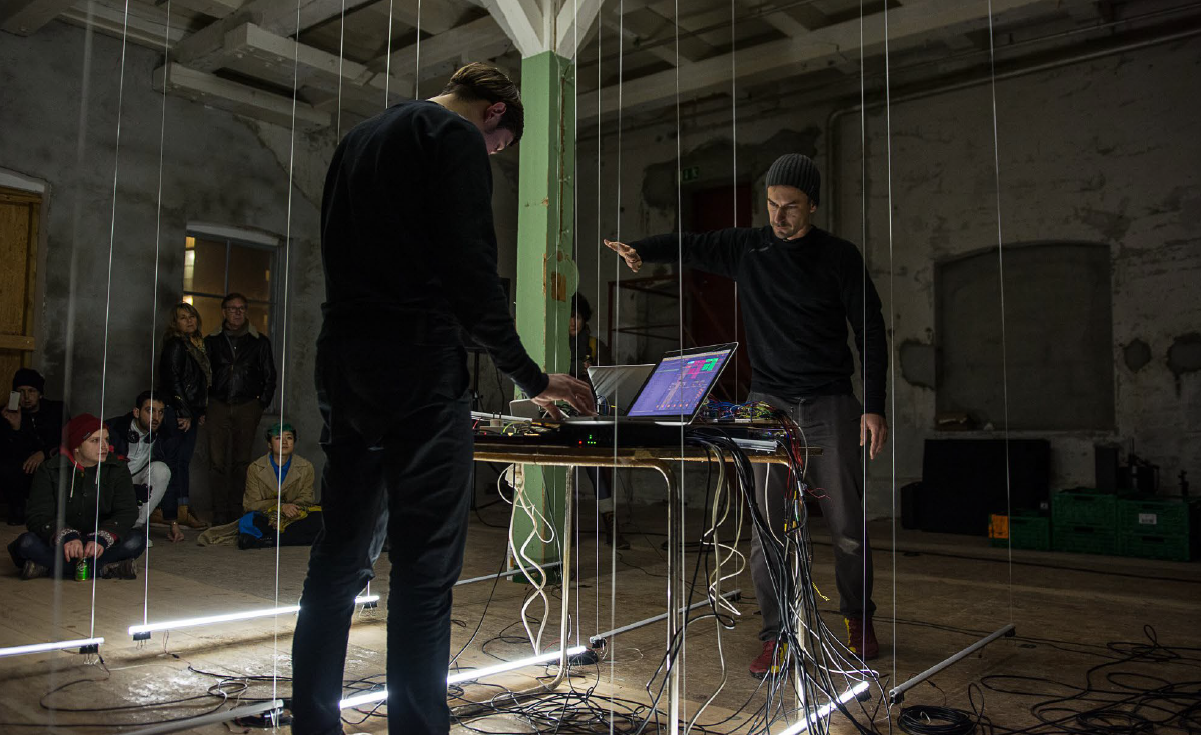Jamky, post-digital musical instrument
Basic information
Project Title
Jamky, post-digital musical instrument
Full project title
Jamky, an environmentally friendly post-digital musical instrument
Category
Regaining a sense of belonging
Project Description
A post-digital musical tool designed for exploration, blending education and creativity. Ideal for individuals or groups, spanning generations and skill levels. Crafted with natural materials—wood and stones—for an acoustic journey of discovery. Also tailored for professional musicians seeking novel forms of acoustic sounds.
Geographical Scope
National
Project Region
Slovakia
Urban or rural issues
It addresses urban-rural linkages
Physical or other transformations
It refers to a physical transformation of the built environment (hard investment)
EU Programme or fund
No
Description of the project
Summary
The essence of the presented project is a post-digital musical instrument called Jamky (in English: dimples, small-scale pits) designed for both individual and group performances. Jamky serves as an educational tool for pupils, students, and teachers, facilitating the creation of sounds and composition of musical structures. It caters to professional musicians seeking innovative performative elements and original acoustic sounds to craft rhythmic structures or harmonic melodies. Additionally, the instrument functions as a standard MIDI sequencer, allowing connection to software supporting the MIDI protocol for music creation or VJing.
Constructed from environmentally friendly materials such as recyclable wood and small river pebbles, alongside electronics sourced from reliable, primarily local suppliers, Jamky embodies sustainability in its creation.
The inspiration for the Jamky project stems from one of the authors' fathers, a sculptor who incorporated pebbles into his relief artworks. The project builds upon this tradition, refining the concept of working with natural materials like wood and stones.
A notable aspect of Jamky is its inclusivity, designed to be accessible across various age groups, making it suitable for both young children and adults. The user interface is deliberately simple and intuitive, ensuring ease of use. The robust design further guarantees durability, capable of withstanding rough handling.
Jamky has been featured at numerous public events, including music, light, and sound festivals, as well as exhibitions in Slovakia and abroad. Regularly integrated into educational activities, it finds application in schools and various educational institutions.
Constructed from environmentally friendly materials such as recyclable wood and small river pebbles, alongside electronics sourced from reliable, primarily local suppliers, Jamky embodies sustainability in its creation.
The inspiration for the Jamky project stems from one of the authors' fathers, a sculptor who incorporated pebbles into his relief artworks. The project builds upon this tradition, refining the concept of working with natural materials like wood and stones.
A notable aspect of Jamky is its inclusivity, designed to be accessible across various age groups, making it suitable for both young children and adults. The user interface is deliberately simple and intuitive, ensuring ease of use. The robust design further guarantees durability, capable of withstanding rough handling.
Jamky has been featured at numerous public events, including music, light, and sound festivals, as well as exhibitions in Slovakia and abroad. Regularly integrated into educational activities, it finds application in schools and various educational institutions.
Key objectives for sustainability
The Jamky project establishes an exemplary standard in sustainability by incorporating key practices that prioritize environmental responsibility. As a tangible musical instrument, Jamky showcases a commitment to eco-friendly principles in various aspects of its design and production.
The project emphasizes a return to nature and childhood experiences,fostering a connection with the environment. The use of natural materials—wood and river pebbles—underscores a dedication to sustainability, ensuring that the materials can be seamlessly reintegrated into the natural cycle. Materials can be returned to nature,with stones going back to the river, and wooden components crushed and composted. The electronics are reusable in other devices, products, or projects. Sustainability is achieved through the utilization of local resources—100% recyclable natural materials—and the use of electronics from local suppliers.
The localization of electronic device manufacturing contributes to a reduced carbon footprint by avoiding the transportation of goods over long distances. By directly engaging with and selecting suppliers committed to fair trade and responsible practices, the project supports ethical and sustainable production.
The recyclability of the entire Jamky product,from its natural components to the electronics,is an exemplary aspect that highlights the project's commitment to circular design. The conscious effort to minimize waste during production and optimize material usage showcases a commitment to environmental caretaking.
In summary, Jamky serves as a model for sustainable design by prioritizing the use of local, recyclable materials, supporting ethical sourcing, and minimizing environmental impact throughout its lifecycle. The object also provides a replicable framework for future projects to follow. Its emphasis on eco-friendly materials, local sourcing, and recyclability sets a standard that can inspire and guide others in the pursuit of sustainable innovation.
The project emphasizes a return to nature and childhood experiences,fostering a connection with the environment. The use of natural materials—wood and river pebbles—underscores a dedication to sustainability, ensuring that the materials can be seamlessly reintegrated into the natural cycle. Materials can be returned to nature,with stones going back to the river, and wooden components crushed and composted. The electronics are reusable in other devices, products, or projects. Sustainability is achieved through the utilization of local resources—100% recyclable natural materials—and the use of electronics from local suppliers.
The localization of electronic device manufacturing contributes to a reduced carbon footprint by avoiding the transportation of goods over long distances. By directly engaging with and selecting suppliers committed to fair trade and responsible practices, the project supports ethical and sustainable production.
The recyclability of the entire Jamky product,from its natural components to the electronics,is an exemplary aspect that highlights the project's commitment to circular design. The conscious effort to minimize waste during production and optimize material usage showcases a commitment to environmental caretaking.
In summary, Jamky serves as a model for sustainable design by prioritizing the use of local, recyclable materials, supporting ethical sourcing, and minimizing environmental impact throughout its lifecycle. The object also provides a replicable framework for future projects to follow. Its emphasis on eco-friendly materials, local sourcing, and recyclability sets a standard that can inspire and guide others in the pursuit of sustainable innovation.
Key objectives for aesthetics and quality
Our intention in this project was to create the simplest user interface accessible to everyone, irrespective of age—ranging from young children (3 years and above) through young adults, adults, to seniors. Users don't need any prior experience with playing a musical instrument, as they can intuitively control and compose music with this product.
One of the key objectives of this project is simplicity—both in control and understanding of how to work with it. The ambition is to add sophisticated elements (features) to the product that may not be immediately obvious or visible, but a professional musician exploring and using Jamky will discover and utilize them.
The fundamental idea behind this project was inspired by Ján Šicko's father, a sculptor who created reliefs and embedded stones into them. Thus, it builds upon a tradition initiated by the father of one of the authors. Simultaneously, the authors of Jamky employed their craftsmanship skills in working with wood, adding a layer of tradition and artisanal expertise to the project.
Jamky are essentially a sound laboratory, a concept that utilizes electromagnets—solenoids or small motors—to generate sound by striking various resonators, strings, sound objects, and more. This innovative approach adds a distinctive sonic dimension to the project, creating a dynamic and interactive musical experience. The use of electromagnets introduces an interesting fusion of technology and traditional sound-producing elements, contributing to the unique character of Jamky as a post-digital musical instrument.
One of the key objectives of this project is simplicity—both in control and understanding of how to work with it. The ambition is to add sophisticated elements (features) to the product that may not be immediately obvious or visible, but a professional musician exploring and using Jamky will discover and utilize them.
The fundamental idea behind this project was inspired by Ján Šicko's father, a sculptor who created reliefs and embedded stones into them. Thus, it builds upon a tradition initiated by the father of one of the authors. Simultaneously, the authors of Jamky employed their craftsmanship skills in working with wood, adding a layer of tradition and artisanal expertise to the project.
Jamky are essentially a sound laboratory, a concept that utilizes electromagnets—solenoids or small motors—to generate sound by striking various resonators, strings, sound objects, and more. This innovative approach adds a distinctive sonic dimension to the project, creating a dynamic and interactive musical experience. The use of electromagnets introduces an interesting fusion of technology and traditional sound-producing elements, contributing to the unique character of Jamky as a post-digital musical instrument.
Key objectives for inclusion
Our project, Jamky, is driven by a commitment to inclusion, ensuring accessibility and affordability for a diverse range of users. Each row in Jamky represents a unique sound, and every column signifies a step in time. Individuals or groups, whether composed of two, three, or more people, can collaboratively create music compositions by placing stones into small holes.
Jamky instrument is designed to cater to a broad spectrum of individuals, from novices to professional musicians and composers, spanning all age groups from small children to seniors. Notably, it also extends its reach to the largest group of (indirect) users—spectators or listeners. The product finds utility in various settings, including homes, educational institutions, public spaces, festivals, and different events. The user interface is robustly crafted to withstand rough handling, particularly when used by children.
Pedagogues utilize Jamky in the field of music education for children and young people, employing it as a tool to explain music theory and motivate students in a meaningful way.
The Jamky instrument is not only accessible to amateurs but also caters to professional musicians seeking new forms of performative elements or original acoustic sounds. It opens up novel possibilities for musicians to express themselves or deliver captivating performances on stage.
A noteworthy characteristic is that Jamky is primarily an analog instrument, standing in contrast to the digital tools commonly used by our target audiences in their daily lives. This deliberate choice enhances the inclusivity of the project, providing an alternative and enriching musical experience. The commitment to inclusion, robust design, and affordability make Jamky an exemplary project in promoting accessibility and diversity in the realm of musical instruments.
Jamky instrument is designed to cater to a broad spectrum of individuals, from novices to professional musicians and composers, spanning all age groups from small children to seniors. Notably, it also extends its reach to the largest group of (indirect) users—spectators or listeners. The product finds utility in various settings, including homes, educational institutions, public spaces, festivals, and different events. The user interface is robustly crafted to withstand rough handling, particularly when used by children.
Pedagogues utilize Jamky in the field of music education for children and young people, employing it as a tool to explain music theory and motivate students in a meaningful way.
The Jamky instrument is not only accessible to amateurs but also caters to professional musicians seeking new forms of performative elements or original acoustic sounds. It opens up novel possibilities for musicians to express themselves or deliver captivating performances on stage.
A noteworthy characteristic is that Jamky is primarily an analog instrument, standing in contrast to the digital tools commonly used by our target audiences in their daily lives. This deliberate choice enhances the inclusivity of the project, providing an alternative and enriching musical experience. The commitment to inclusion, robust design, and affordability make Jamky an exemplary project in promoting accessibility and diversity in the realm of musical instruments.
Results in relation to category
The Jamky project made its mark at various exhibitions both in Slovakia and abroad. In Slovakia, we showcased it during the White Night festival in Bratislava and Košice, as well as at the Bratislava Design Week. Our successful presentations extended beyond borders, earning mentions in the media. Audiences had the chance to experience Jamky at the Screencity festival in Bergen, Norway, the Memory exhibition in Vienna, Austria, and even oversees in New York during PAF Pioneer Works, where they were part of an ensemble of audiovisual presentations and installations.
Jamky, functioning as an educational tool, found application in workshops conducted at progressive schools like Narnia and Edulienka in Bratislava. It also played a role in workshops at the New Synagogue in Žilina, a hub for contemporary art and culture. These diverse exhibitions and educational activities have collectively contributed to the project's resonance and outreach.
Jamky, functioning as an educational tool, found application in workshops conducted at progressive schools like Narnia and Edulienka in Bratislava. It also played a role in workshops at the New Synagogue in Žilina, a hub for contemporary art and culture. These diverse exhibitions and educational activities have collectively contributed to the project's resonance and outreach.
How Citizens benefit
The Jamky product is designed for diverse age groups, encompassing individuals with varying levels of musical education, experience, or none at all. It is important to emphasize the tactile dimension of this product, particularly as a welcomed alternative for children and young people in contrast to the digital tools used almost daily.
Musicians: Jamky are intended for musicians to test and explore the creative potential of the instrument within the context of their artistic endeavors.
Educators and Students: Jamky cater to the educational needs within music education, both in artistic schools and various workshops across different educational institutions. Our intention is to place Jamky in various schools, gather their experiences, and create studies for educators and students. The process of creating musical compositions visually demonstrates the method of "programming," involving algorithm control and program creation. The eight positions in a row represent one byte, with each hole as 1 bit. This offers a visual way for students to understand how the binary system functions.
General public: Members of general public are and will continue to be involved in using Jamky during public presentations, such as festivals (in the past White Night, Sensorium), or gallery exhibitions. Exploring reactions and interaction with Jamky in this target group remains a valuable source of insights for further directing Jamky as a universal and intuitive tool. Based on their responses, we can formulate new requirements or updates.
Audience: Constituting a passive yet the most numerous group of Jamky users, audience plays a crucial role. By nature, Jamky is a democratic instrument, inviting every viewer to try it out. Viewers are motivated towards a deeper interest in music creation, fostering active cultural participation beyond mere observation.
Musicians: Jamky are intended for musicians to test and explore the creative potential of the instrument within the context of their artistic endeavors.
Educators and Students: Jamky cater to the educational needs within music education, both in artistic schools and various workshops across different educational institutions. Our intention is to place Jamky in various schools, gather their experiences, and create studies for educators and students. The process of creating musical compositions visually demonstrates the method of "programming," involving algorithm control and program creation. The eight positions in a row represent one byte, with each hole as 1 bit. This offers a visual way for students to understand how the binary system functions.
General public: Members of general public are and will continue to be involved in using Jamky during public presentations, such as festivals (in the past White Night, Sensorium), or gallery exhibitions. Exploring reactions and interaction with Jamky in this target group remains a valuable source of insights for further directing Jamky as a universal and intuitive tool. Based on their responses, we can formulate new requirements or updates.
Audience: Constituting a passive yet the most numerous group of Jamky users, audience plays a crucial role. By nature, Jamky is a democratic instrument, inviting every viewer to try it out. Viewers are motivated towards a deeper interest in music creation, fostering active cultural participation beyond mere observation.
Physical or other transformations
It refers to a physical transformation of the built environment (hard investment)
Innovative character
As previously mentioned, this instrument stands out as a remarkable alternative to the prevalent digital tools widely used today, even among children. It represents an innovative shift towards analog instrumentation, embracing the tactile experience, enticing users to explore a spectrum of sound colors. Its educational nature adds a distinctive dimension, fostering a deeper understanding of the auditory world.
In stark contrast to mainstream digital instruments, Jamky captures the essence of haptic engagement, providing a sensory-rich experience that transcends the virtual realm. This analog character, coupled with its educational focus, positions Jamky as a pioneering force in the musical instrument landscape.
Moreover, Jamky's versatility extends beyond its standalone capabilities. The ability to connect multiple objects to form a cohesive whole unlocks a realm of possibilities—more entertainment, more musical variations, and the creation of a unique musical orchestra. This collaborative potential sets Jamky apart from conventional instruments, offering a dynamic and interactive musical experience that redefines the boundaries of traditional music-making.
In essence, Jamky represents an innovative departure from the mainstream, offering a tangible, educational, and interconnected musical journey that challenges the status quo in the digital-dominated landscape of contemporary musical instruments.
In stark contrast to mainstream digital instruments, Jamky captures the essence of haptic engagement, providing a sensory-rich experience that transcends the virtual realm. This analog character, coupled with its educational focus, positions Jamky as a pioneering force in the musical instrument landscape.
Moreover, Jamky's versatility extends beyond its standalone capabilities. The ability to connect multiple objects to form a cohesive whole unlocks a realm of possibilities—more entertainment, more musical variations, and the creation of a unique musical orchestra. This collaborative potential sets Jamky apart from conventional instruments, offering a dynamic and interactive musical experience that redefines the boundaries of traditional music-making.
In essence, Jamky represents an innovative departure from the mainstream, offering a tangible, educational, and interconnected musical journey that challenges the status quo in the digital-dominated landscape of contemporary musical instruments.
Disciplines/knowledge reflected
The design of the Jamky product is a crucial aspect, intertwining artistic expression with functionality and intuitive controls, a crucial consideration given its diverse target audience. This audience spans from children and youth to adults and seniors, encompassing both musical novices and professional musicians.
In bringing this project to life, the collaboration of experts from various fields played a pivotal role. The conceptualization of the product's design involved a tandem effort between a designer, shaping the product concept, and another product designer responsible for the actual design. Furthermore, an expert in electrical engineering contributed significantly to the project, guiding us in optimizing the design and creating printed circuit boards.
A notable aspect of the project was the active engagement of musicians, providing a unique and valuable perspective in this interdisciplinary endeavor. Their involvement extended to testing prototypes and offering invaluable feedback, a critical contribution in refining the product. This dynamic interaction between design, engineering, and musical expertise resulted in a harmonious fusion of artistic vision, technical precision, and user-friendly functionality.
Equally crucial was the role of the audience throughout this process. Regular testing and feedback sessions involving diverse audience members, from musical enthusiasts to those unfamiliar with traditional instruments, allowed us to tailor the design to meet their expectations and preferences. Their insights played a fundamental role in shaping the final product, ensuring it resonated effectively with its intended users.
The interdisciplinary collaboration, enriched by the active involvement of the audience, proved transformative. This synergy of diverse perspectives not only elevated the design and functionality standards of Jamky but also ensured its relevance and appeal to a broad user base.
In bringing this project to life, the collaboration of experts from various fields played a pivotal role. The conceptualization of the product's design involved a tandem effort between a designer, shaping the product concept, and another product designer responsible for the actual design. Furthermore, an expert in electrical engineering contributed significantly to the project, guiding us in optimizing the design and creating printed circuit boards.
A notable aspect of the project was the active engagement of musicians, providing a unique and valuable perspective in this interdisciplinary endeavor. Their involvement extended to testing prototypes and offering invaluable feedback, a critical contribution in refining the product. This dynamic interaction between design, engineering, and musical expertise resulted in a harmonious fusion of artistic vision, technical precision, and user-friendly functionality.
Equally crucial was the role of the audience throughout this process. Regular testing and feedback sessions involving diverse audience members, from musical enthusiasts to those unfamiliar with traditional instruments, allowed us to tailor the design to meet their expectations and preferences. Their insights played a fundamental role in shaping the final product, ensuring it resonated effectively with its intended users.
The interdisciplinary collaboration, enriched by the active involvement of the audience, proved transformative. This synergy of diverse perspectives not only elevated the design and functionality standards of Jamky but also ensured its relevance and appeal to a broad user base.
Methodology used
In the development and production of the Jamky product, our aim was to create the simplest, most user-friendly, and intuitive musical instrument. The process began with the formulation of the concept, followed by consultations between designers, an electrical engineering expert, and professional musicians. Through this collaborative effort and the synthesis of all information and input, we crafted the initial prototype, subjecting it to rigorous testing by professional musicians.
The insights garnered from these musicians were integral in refining and enhancing the prototype, resulting in a fully functional iteration. This functional prototype was then showcased at various public events and exhibitions, where we closely observed the reactions of both children and adults as they interacted with the instrument. The feedback collected from these experiences underwent thorough analysis, guiding us in iterative improvements and the continual evolution of the product.
This methodology allowed us to ensure that Jamky not only met our initial vision but also resonated effectively with users of diverse ages and musical backgrounds. The iterative nature of our approach, coupled with the incorporation of user feedback, played a pivotal role in shaping the final product into a harmonious blend of simplicity, intuitiveness, and musical innovation.
The insights garnered from these musicians were integral in refining and enhancing the prototype, resulting in a fully functional iteration. This functional prototype was then showcased at various public events and exhibitions, where we closely observed the reactions of both children and adults as they interacted with the instrument. The feedback collected from these experiences underwent thorough analysis, guiding us in iterative improvements and the continual evolution of the product.
This methodology allowed us to ensure that Jamky not only met our initial vision but also resonated effectively with users of diverse ages and musical backgrounds. The iterative nature of our approach, coupled with the incorporation of user feedback, played a pivotal role in shaping the final product into a harmonious blend of simplicity, intuitiveness, and musical innovation.
How stakeholders are engaged
The development of this innovative product has been a collaborative effort with diverse stakeholders engaged at various levels.
The creative space for this project was provided by the Academy of Fine Arts and Design in Bratislava. Designer and artist, Ján Šicko initiated the project as part of his doctoral thesis, laying the conceptual foundation. The addition of his colleague Roman Mackovič, who became a co-author contributing to the design and assembling of electronic components, marked a pivotal moment in the project's evolution. The active involvement of musician Jonatán Pastirčák, from the project's inception, added a vital musical perspective, bridging the realms of design, technology and sound.
In terms of stakeholder involvement, the implementation of this product unfolds across various levels. At the local level, parents of young children play a fundamental role. They can seamlessly incorporate Jamky into their homes, offering a simple yet effective means to introduce their children to music education and cultivate a positive relationship with music from an early age.
Moving to the regional level, educators in schools actively engage with Jamky, not only within the field of music education but also across diverse collaborative projects. The interactive nature of Jamky, being controllable by multiple individuals simultaneously, fosters an environment conducive to teamwork and collaboration. The added value lies in the enhancement of educational methodologies, promoting a holistic approach to learning.
On the international level, professional musicians find significant value in Jamky for composing music. Whether in intimate chamber concerts or on grand festival stages, their engagement contributes a layer of creative exploration and innovation to the musical landscape. The added value manifests in the expansion of possibilities for professional musicians, introducing a novel tool into their creative repertoire.
The creative space for this project was provided by the Academy of Fine Arts and Design in Bratislava. Designer and artist, Ján Šicko initiated the project as part of his doctoral thesis, laying the conceptual foundation. The addition of his colleague Roman Mackovič, who became a co-author contributing to the design and assembling of electronic components, marked a pivotal moment in the project's evolution. The active involvement of musician Jonatán Pastirčák, from the project's inception, added a vital musical perspective, bridging the realms of design, technology and sound.
In terms of stakeholder involvement, the implementation of this product unfolds across various levels. At the local level, parents of young children play a fundamental role. They can seamlessly incorporate Jamky into their homes, offering a simple yet effective means to introduce their children to music education and cultivate a positive relationship with music from an early age.
Moving to the regional level, educators in schools actively engage with Jamky, not only within the field of music education but also across diverse collaborative projects. The interactive nature of Jamky, being controllable by multiple individuals simultaneously, fosters an environment conducive to teamwork and collaboration. The added value lies in the enhancement of educational methodologies, promoting a holistic approach to learning.
On the international level, professional musicians find significant value in Jamky for composing music. Whether in intimate chamber concerts or on grand festival stages, their engagement contributes a layer of creative exploration and innovation to the musical landscape. The added value manifests in the expansion of possibilities for professional musicians, introducing a novel tool into their creative repertoire.
Global challenges
A crucial aspect lies in the sustainability of the project, rooted in the utilization of local resources that can be reused, recycled, or even returned to nature.
The project leverages the expertise of its two main creators, Ján Šicko and Roman Mackovič, for whom Jamky is not the sole innovative product in their repertoire.
Beyond innovation, the product erases social and educational disparities, as it can be accessible to all individuals expressing an interest, even those unable to purchase it. Our vision includes placing Jamky in schools and public spaces such as galleries and festivals, ensuring accessibility to diverse groups of people.
The project leverages the expertise of its two main creators, Ján Šicko and Roman Mackovič, for whom Jamky is not the sole innovative product in their repertoire.
Beyond innovation, the product erases social and educational disparities, as it can be accessible to all individuals expressing an interest, even those unable to purchase it. Our vision includes placing Jamky in schools and public spaces such as galleries and festivals, ensuring accessibility to diverse groups of people.
Learning transferred to other parties
We envision offering the Jamky project in the near future as a "kit" that its future users can assemble themselves. This kit can be utilized independently, but it also seamlessly integrates as part of larger ensembles, especially for musicians participating in musical groups.
The replicability of our project lies not only in the physical components but also in its analog dimension, educational attributes, and the promotion of creativity. By providing users with the opportunity to assemble their own instruments, we aim to empower them to engage in a hands-on, educational experience, fostering a deeper connection with the musical creation process.
Furthermore, the analog nature of this project serves as an inspirational element for other initiatives, emphasizing a departure from the digital norm. The educational qualities embedded within Jamky can be adapted and replicated to cater to diverse learning environments, promoting creativity and a sensory connection to music.
In summary, the Jamky project's replicability extends beyond the assembly of physical components. It encompasses the educational approach, the analog essence, and the encouragement of creativity, making it adaptable to various contexts, groups, and places.
The replicability of our project lies not only in the physical components but also in its analog dimension, educational attributes, and the promotion of creativity. By providing users with the opportunity to assemble their own instruments, we aim to empower them to engage in a hands-on, educational experience, fostering a deeper connection with the musical creation process.
Furthermore, the analog nature of this project serves as an inspirational element for other initiatives, emphasizing a departure from the digital norm. The educational qualities embedded within Jamky can be adapted and replicated to cater to diverse learning environments, promoting creativity and a sensory connection to music.
In summary, the Jamky project's replicability extends beyond the assembly of physical components. It encompasses the educational approach, the analog essence, and the encouragement of creativity, making it adaptable to various contexts, groups, and places.
Keywords
instrument
music
post-digital
physical-digital
design

